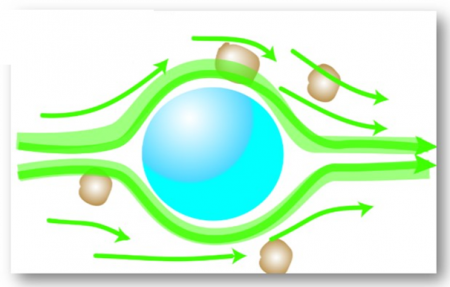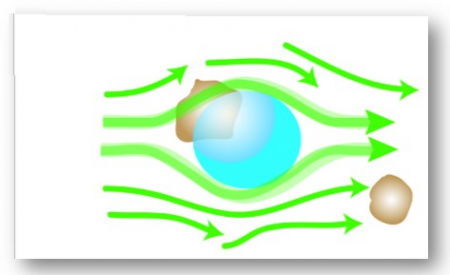Is Water the Best Coal Dust Suppressant?
Not Really.
Water-only dust control systems have been used widely throughout the coal industry as a low-cost coal dust suppressant. At first glance, water seems like the natural solution to coal dust because it is safe and cheap. However, upon closer inspection, water is neither safe nor cheap. Water-only coal dust suppression systems use high volumes of water to wet coal fines and temporarily adhere them to larger coal pieces in order to prevent the fines from becoming airborne. This massive addition of water robs coal of its BTUs (heating value), causes plugging in chutes and hoppers, and creates a slippery environment. Water also offers no residual dust suppression performance. The weak bonds created by the moisture addition disappear upon drying, making the fines vulnerable to becoming airborne once again. Water-only coal dust suppression systems look attractive on paper because of their relatively low price tag and their ease of installation. However, over half of the water-only systems installed in the last 10 years are currently inoperable due to lack of maintenance or due to lack of performance.
Why Doesn’t Water Work for Coal Dust Suppression?
Because coal is hydrophobic . . . water-hating. Coal in its dustiest form is dry and friable fines. When water droplets meet with dry coal fines, the immediate reaction is a repulsion of the water from the surface of the coal. This is demonstrated clearly in the video below. This same repulsion occurs when water is sprayed directly into coal processes (i.e. coal crushing, coal transferring, coal stack-out, coal reclaiming, etc.) as well as when water is sprayed into the air around a dusty process (i.e. dry fog systems, wet misting systems, water fan cannons, etc.).
Left beaker is treated (1 part ionic surfactant : 400 parts water).
Right beaker is untreated (water-only).
Swing and a Miss.
Water-only dust suppression systems bombard the air with small water droplets, hoping those droplets will collide with airborne coal dust particles. It’s like hoping to hit a curve ball blind-folded. You’re going to miss more than you’re going to connect. This is compounded by the fact that respirable coal dust fines in the 2-10 micron range are much smaller than the water droplets produced by water-only dust suppression systems. The turbulence of the water droplets moving through the air creates a powerful air flow around them. The dust fines move around the water droplet, as shown in the slip-stream image below.

Turbulence of the water droplets moving through the air creates a powerful air flow around them, causing the dust fines to move around them and resulting in less effective dust control.
If Water is not the Answer, then What is?
Wetter water. How can you make water wetter? The right blend of non-ionic and anionic surfactants blended with penetrants, dispersants, and binding agents will produce a wetter water capable of targeting dust fines and locking them down for weeks or even months.
As shown in the video, a small amount of the right surfactant chemistry will go a long way. A shot-glass of the right chemistry will make 4-5 gallons of water up to 200X wetter by lowering the surface tension of the water, and changing the ionic charge to the opposite charge of coal fines. This opposing charge allows the treated water droplets to attract coal dust fines like a magnet, overcoming the coal’s hydrophobic nature. The binding agents incorporated into the chemistry cause the fine to adhere to lump coal and other fines, preventing it from becoming airborne even after the treatment dries.
Swing and a Home Run.
Wetter water allows for the production of smaller droplets, reducing the volume of water required. Wetter water also means every water droplet has 200X better odds of connecting with a dust fine. This means better dust control performance when applied directly into coal processes, and better dust control performance when sprayed into the air around a dusty process. The image below demonstrates how a smaller, oppositely charged water droplet will attract dust fines, wetting them faster. Better results are achieved using a fraction of the volume of water.

Smaller, oppositely charged water droplet will attract dust fines, wetting them faster and resulting in better dust control.
Wetter water reduces water consumption by as much as 1/20th and has a dust control efficacy of more than 95%. Water conservation is a growing concern in all industries, but especially in the coal-fired power industry. The reduction in water consumption not only saves money, but also reduces or eliminates slippery conditions, creating a safer working environment. The reduction in water also lowers or eliminates the impact on BTUs, allowing coal-fired power plants to get the maximum heating value from their coal. By reducing the moisture addition to coal, chute, bunker, and hopper pluggage is greatly reduced, preventing derates while improving operational efficiency.
Can Existing Water-Only Dust Suppression Systems be Modified to Improve Performance and Reduce Water Consumption?
Yes, MinTech has been retro-fitting water-only dust suppression systems since 1998. The process is simple, starting with a free site survey performed by one of MinTech’s engineers. During the upgrading process, MinTech engineers will work with MinTech chemists to create a program customized for your exact needs. The equipment installed will meet your needs and your budget. The chemicals employed will be compatible with your water, formulated for your coal, and developed to meet your safety and environmental health requirements.
Who Will Service My Dust Suppression System?
MinTech will. MinTech services every dust suppression system we install at no charge. We know that dust suppression chemicals will only perform properly if they are applied properly. That’s why our service technicians perform routine maintenance on every system we service.
For more information on our services or to schedule a free on-site demonstration, please contact us.
